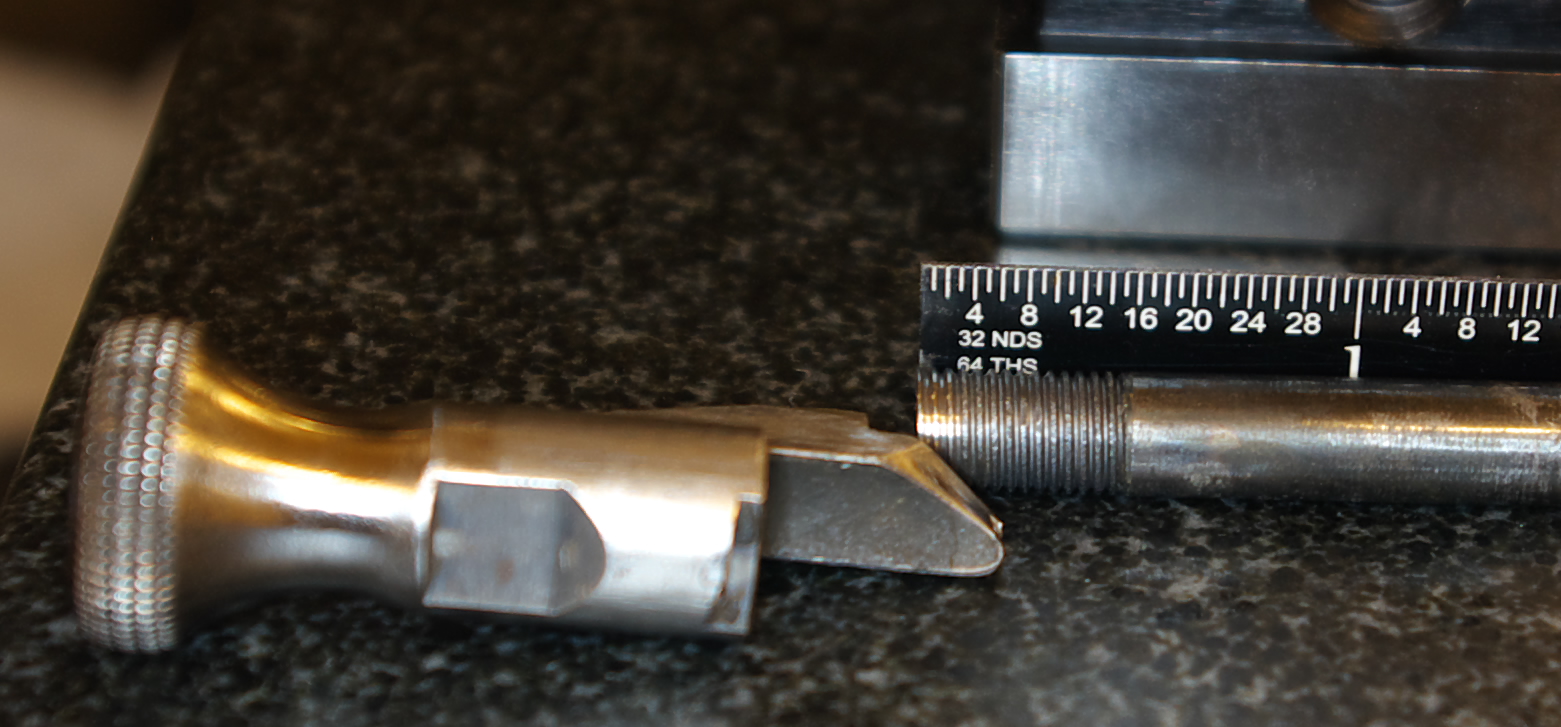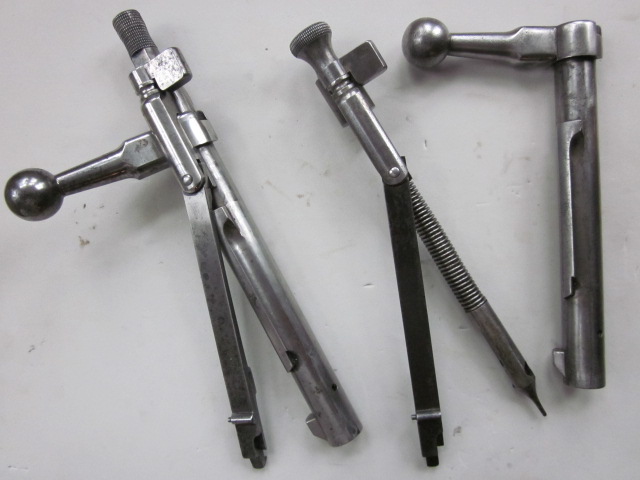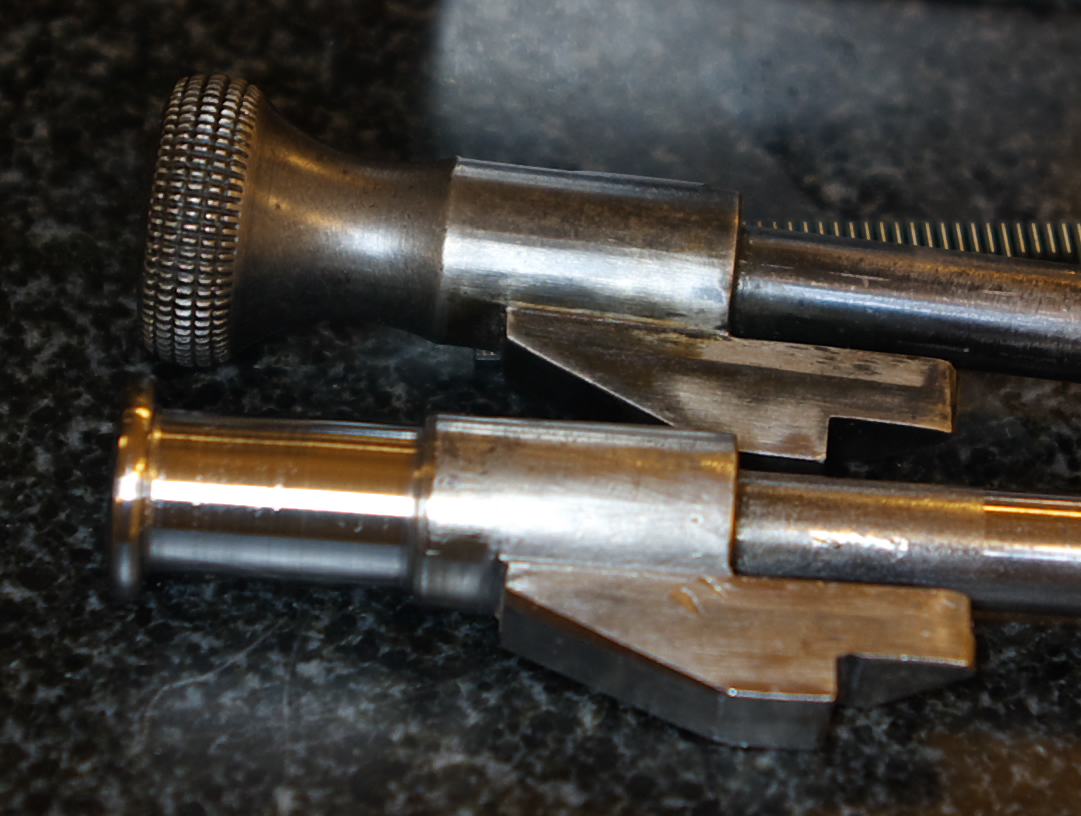As a last step to accurizing my US Krag collection, I have gauged my Model 1898s for sear spring and main spring tension. Since they all have a different shooting feel when I bring a set to the range, I was not surprised to find a lot of varance. Last time out I had one where the trigger was actually sticking a bit and it caused a noticeable jump when fired it may be that I neglected to grease the bolt/sear sufficiently however that rifle has been quarantined until I review the rest of my collection. For starters, I am planning to re-inspect all of my main springs, sear springs and the polish/sharpness of the faying surfaces. For the main springs, I use the 38.5-coil variety listed in Mallory (page 214) which are usually about 5 1/8 long. Sear springs I have previously identified by look after some 35 years of playing with these things, I have spotted many oddities. So, with all of my springs LOOKING the same, I bought a 25# trigger pull gage from Midway and found my trigger pulls vary from 3.5# to 6# (most falling around 4.5#) and my main springs vary from 13# to 17# (pre-1901s averaging 14#; post-1901s averaging 15.5#). [FYI: I created a copper wire lasso to hang on to my cocking knob & pulled until the sear was engaged.] Mallory says that main spring weight was to be 16# to 18#. I am curious if anyone else has ever reviewed this on their rifles and, if so, what their results were? Before I start tearing through my bucket of springs and trying to mix/match, I want to set a goal for the spring compression weights. When I correlate by data with my favorite rifles, it is apparent that I have enjoyed the 4 to 4.5# trigger pulls the best over the years however I suspect that most of my main springs are a bit too weak.
Krag Spring Compression Weights
Krag Spring Compression Weights
A vote is like a rifle; its usefulness depends upon the character of the user. Theodore Roosevelt
-
madsenshooter
- Posts: 1179
- Joined: Thu Sep 10, 2009 5:00 am
- Location: Upper Appalachia aka SE Ohio
Re: Krag Spring Compression Weights
I've not gone into the detail you have, I bought a Wolff 26# once, hoping to decrease lock time a bit, but found it pierced the primer in most of the rifles I tried using it in. I never got a lot of gas escaping out of the action, but enough to be hard on the firing pin tip. It was not easy to get that 26# spring on my parkerized Krag as it has a modified 92 bolt sleeve with longer securing stud (sorta between Poyer 2A and 3 bolt sleeve) to fit the uncut guide rib 92 bolt.
Re: Krag Spring Compression Weights
A bought a Wolff 22# from Midway about 5 years back and although it did not puncture any primers, the indents were so severe I was afraid it would do so before long so I stopped using it. It was so hard to assemble the bolt that I was afraid of that the firing pin until it was locked into the bolt. If I can still find it, I may try the gauge on that one.
A vote is like a rifle; its usefulness depends upon the character of the user. Theodore Roosevelt
Re: Krag Spring Compression Weights
It's SPRING time! I have gauged, measured and counted the coils on most all the Krag springs I have and that necessitated several take-downs. Then I mix-and-matched to get some uniformity going in the collection. The older 1898s with the square cut barrel faces were the test subjects simply because these are the ones I had slated to be next to go to the range these averaged at 14#-to-cocked; I upped these to 15#. All triggers were spring-matched to 4#. Worked very well at 100 yards (see image) using the tried-and-true: 220 grain Hornady RN with 40gr IMR 4350 & standard Winchester LR primers. It is especially encouraging considering I only shot about 25-30 rounds between two rifles prior to getting those two 3-shot groups in sequence. Even more so because I am a no marksman, havent been to range since 2013, was using iron sights, the wind was gusting and I am new to wearing prescription glasses. So now the question is if 16# or 17# will be better? One problem is that when the main spring goes up, there is some creep in the trigger weight and I have about used-up all of my wimpiest OEM trigger springs. The newer 1898s I have (rounded barrel faces) are pretty much split with 16-to-17#-to-cocked with trigger weights averaging at 5#. I will likely try for 16# mains and live with 5# triggers to test. BTW I found my Blitzshell Main Spring (Card says 22Lbs) and tested it: 26#-to-cocked (yikes)! So, it seems that there are different ways to measure spring weight because that is WAY too much force (much more than an 16-18# OEM). That said, my quest for the best combination shall continue. I strongly suspect it will also vary by the loads I use just another variable to consider. I hope this info is of some use to all you all...

A vote is like a rifle; its usefulness depends upon the character of the user. Theodore Roosevelt
Re: Krag Spring Compression Weights
I see that others have been pursuing higher spring tensions maybe to decrease lock times? I was thinking of cutting off the knob to reduce the speed time on my Krag sporter that I am working on. That would have been a bad idea. The threads are less than 1/2 long and only in the knob area. The attached foto shows the cocking piece and rod disassembled. The unmodified assembly weighs .1825 lbs. I checked 2 and the weight is exactly the same. The rod on original Krags is screwed into the cocking piece and the end of the rod is then severely peened once the correct overall length is established. After peening the rod the end was ground and polished so the cocking piece and rod blend together very nicely. The threads on the end of the rod were swelled for several turns as seen by the shinny finish. The rod is not particularly hard but the cocking piece has a very hard case. I am planning on reducing the knob diameter and milling 3 grooves in the rod to reduce the weight. I will not be able to measure any reduction in the lock time but can post finished fotos and weight reduction if anyone is interested.

- butlersrangers
- Posts: 9900
- Joined: Wed Oct 07, 2009 11:35 pm
- Location: Below the Bridge, Michigan
Re: Krag Spring Compression Weights
'FredC': One of these days I will have to weigh a regular Krag Striker-rod and my 'Headless' Striker-rod and see if there is a significant weight difference. Springfield Armory built these for a brief time (on carbines and rifles) for 'cost savings', which did not pan out. They returned to the regular Striker-rod. I have not noticed a difference in "lock-time" with the streamlined knob.
The regular Knob on the Krag Striker-rod was considered to provide a degree of protection to the eye (by diverting escaping gases in the event of a case failure or pierced primer). It is also a more convenient assist for Bolt disassembly and reassembly. (It's also kind of Pretty and makes a Krag a Krag).
There are down sides to eliminating too much of the Knob. A good 'trigger job' and graphite would pay greater dividends - IMHO.
The regular Knob on the Krag Striker-rod was considered to provide a degree of protection to the eye (by diverting escaping gases in the event of a case failure or pierced primer). It is also a more convenient assist for Bolt disassembly and reassembly. (It's also kind of Pretty and makes a Krag a Krag).
There are down sides to eliminating too much of the Knob. A good 'trigger job' and graphite would pay greater dividends - IMHO.

Re: Krag Spring Compression Weights
It took an hour or so to modify the cocking piece with a surface grinder with a spin fixture and a tool room lathe. I only gained .02 lbs or 1/3 of an ounce. It may take a competitive shooter to notice the difference, and he could get a little bit more weight savings by eliminating the remnants of a knob that I left and putting in a snap ring groove to facilitate take down. If I get the time a may mill some grooves in the rod in a length wise direction with a ball end mill. I would expect a little less gain from that. The best improvement would be to install a titanium rod. Was not aware of the special carbine striker/rod assembly.

- butlersrangers
- Posts: 9900
- Joined: Wed Oct 07, 2009 11:35 pm
- Location: Below the Bridge, Michigan
Re: Krag Spring Compression Weights
Although often associated with the Model 1899 Carbine, the 'headless' cocking-piece was an economy move and probably also appeared on Rifles. Mallory and Poyer books both place it occurring in 1900, on Krags ranging from #202,000 to #285,000. It was discontinued due to being more expensive than the 'knob' version.

Re: Krag Spring Compression Weights
If one assumed they used round bar stock to make the cocking piece you would need the same size bar for both styles. The reduced diameter one would have taken more cycle time to remove the extra material and the same thing with the knurling. I have been a production machinist for 40 years and never pick up a Krag and not wonder how they did all those set ups.
BR, I went back and looked at the first post mentioning the headless style and you did say both carbines and rifles.
BR, I went back and looked at the first post mentioning the headless style and you did say both carbines and rifles.
Re: Krag Spring Compression Weights
I spoke with Dave at Wolff Gunsprings yesterday. He said that it was highly unlikely that my package contained the incorrect (higher force of 26#) spring but would replace it under warranty if I desired. He also mentioned that the spring could be trimmed down to reduce the force. I said I will consider the later option. On the question, he said that in the 25 years or so he has been making the US Krag main springs, he cannot recall ever receiving any complaints or other feedback. He also said that he has not sold many of them. I offered by concerns regarding possible rupturing of the primers and that a weaker version of the spring would likely prove a popular seller. I offered the results of my testing of his spring and my best originals and he said the weights of springs are not determined as such it pertains to one inch of travel. He said the original springs have unquestionably relaxed since new (I would be fool to disagree). Still I said, too much is too much I thanked him for his time and said I would do some testing.
A vote is like a rifle; its usefulness depends upon the character of the user. Theodore Roosevelt
